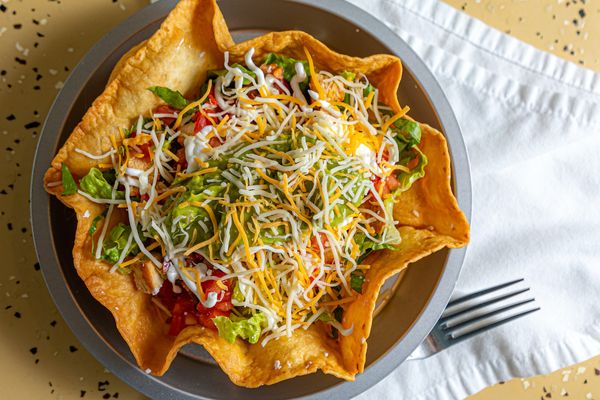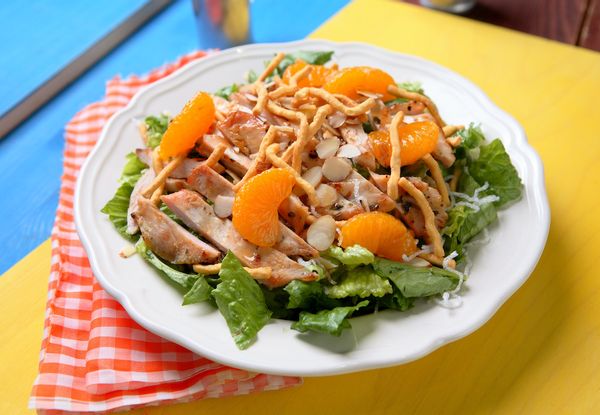In praise of the maximalist salad

When chef Roy Choi set out to make the perfect salad for people who hate salad, he knew exactly the feeling he was chasing: that moment when you’re 13 or 14 — when everything about you feels scrutinized: your body, your choices, your appetite — and suddenly, you’re set loose at a TGI Friday’s or Sizzler, or even the fake-plant-covered solarium of a Wendy’s. No rules. No adults hovering. Just you and the salad bar, with its chilled metal bins and endless possibilities. It felt like freedom.
“This salad is for people who never really liked to eat salads,” he told me in a recent Zoom conversation. “But the one salad we did like to eat? The salad bar salad.”
At the salad bar, no one could tell you what to do or what not to eat. You weren’t being lectured about your choices. You were choosing. Choi — known best as the creator of the gourmet Korean-Mexican taco truck Kogi and for his turn on “The Chef Show” with Jon Favreau — calls it a kind of force field. A portal. Like putting headphones on in a loud room and turning up the volume.
“Even if someone was always on your ass, like, ‘You can’t eat this, you’re eating too much of that,’ they couldn’t say anything,” Choi said. “Because it said ‘salad,’ that word protected you. You were in control.”
So yeah, maybe you only took three leaves of chopped lettuce. Maybe you piled on corn, macaroni salad, tortilla strips and three scoops of ranch. It didn’t matter. You made your own rules. That’s what Roy’s calling back to with his Big F**king Salad, a recipe that’s a maximalist monument to flavor and autonomy, packed with greens, corn, button mushrooms, apple slices, orange segments, cheese and options for crunch. It’s not just a cheeky name — it’s a thesis. One that echoes the larger philosophy of “The Choi of Cooking,” his new book built on balance, compassion and a rejection of the all-or-nothing thinking so many of us carry about food.
“If a salad could eat like a cheeseburger,” he said, “this is it.”
After our conversation, I couldn’t stop thinking about maximalist salads.The ones that thumb their nose at restraint. That lean into crunch and salt and creaminess, into things piled on top of other things. They’re playful. Indulgent. Built more like a love song to autonomy than a side dish. A salad that makes you feel — truly feel — something.
Maybe they’re healthy. Maybe they’re not. Maybe that’s not even the point.
So when the craving finally tipped into obsession, I did the only logical thing: I went to the Cheesecake Factory, a palace to maximalism in both execution and design.
The Cheesecake Factory doesn’t do subtle. It does grandeur, with a wink. Faux-Greek columns rise like they’re holding up the heavens; murals swirl across the ceiling in the color palette of a piña colada; the lighting is the same warm gold as melted butter. The menu is less a document than an ordeal — a spiral-bound tome with the heft of a toddler and the narrative arc of a theme park ride. Even the bathrooms are opulent in that uncanny, chain-restaurant way: part suburban shopping plaza, part Ancient Egyptian bathhouse, all backlit marble and echoing tile.
And then there’s their selection of salads.
There are a few minimalist options, the kind you’d find in any chain’s salad chapter. For instance, there’s a tossed green salad with crisp iceberg wedges that snap under your fork, with ribbons of curled carrot, cucumber slices, tomato hunks and a little metal cup of dressing waiting quietly on the side. Then there’s the “Almost Traditional” Caesar, with croutons toasted just shy of bitter and parmesan dusted like snowfall.
But most of the menu is unapologetically maximalist — a salute to abundance and texture piled high. Take the Mexicali Salad: fire-roasted corn kernels that pop with a whisper of smoke, buttery avocado slices, crisp and nearly translucent ribbons of jicama, sharp onion, tender white beans and mixed greens tangled with salty crumbles of cotija cheese and toasted pepitas. It’s crowned with a scatter of crisp tortillas that snap under your teeth.
The Fried Chicken Club salad doesn’t mess around either — crispy fried chicken crackling with every bite, tangled in mixed greens, smoky shards of bacon and bold blue cheese crumbles. There are jewel-toned tomato chunks, cool cucumber slices, and punchy rings of onion, all drizzled with a honey-Dijon vinaigrette.
Even the vegan Cobb leans toward abundance rather than austerity: crisp lettuce leaves, spears of grilled asparagus, earthy roasted beets, snappy green beans, nutty quinoa and chewy farro, all tossed with crunchy almonds and pepitas to seal the deal.
But as I settled into my booth, the kind of faux-leather banquette that makes a gentle whoosh under your thighs and smells faintly of buttered toast and upholstery cleaner, a thought nudged its way to the front of the line: If I’m going to eat 800 calories, shouldn’t I just order pasta instead of a Barbeque Ranch Chicken Salad, a riot of creamy avocado, tomato, grilled corn and black beans finished with a tangled bird’s nest of crispy fried onion strings?
It was a quiet little reflex, leftover from decades of diet messaging. Somewhere deep in the wiring, there was still this belief that a salad, no matter how decadent, was supposed to be a kind of penance. Something virtuous. Something small. (The aforementioned tossed green salad, it should be noted, also champions the “Skinnylicious” menu, where nothing tops 590 calories.) But that’s missing the point.
 Cobb salad (Getty Images/ Glasshouse Images)The Big F**king Salad isn’t just Roy Choi’s rebellion; it’s part of a proud, sometimes absurd and completely joyful tradition of maximalist entrée salads. Salads that aren’t here to keep you small, but to satisfy. To delight. To hand you back your appetite without apology. They straddle the line between indulgence and wellness, pleasure and penance. And they do it with flair.
Cobb salad (Getty Images/ Glasshouse Images)The Big F**king Salad isn’t just Roy Choi’s rebellion; it’s part of a proud, sometimes absurd and completely joyful tradition of maximalist entrée salads. Salads that aren’t here to keep you small, but to satisfy. To delight. To hand you back your appetite without apology. They straddle the line between indulgence and wellness, pleasure and penance. And they do it with flair.
Take the Quesadilla Explosion Salad at Chili’s. A truly decadent mix of grilled chicken, cheese, tomatoes, corn salsa, and tortilla strips, tossed in citrus-balsamic and topped — because why not — with actual cheese quesadilla wedges. I worked there as a student and at least once a week, usually Friday nights when the end of a shift felt slightly celebratory, I’d order one to eat hunched over the pass. Red polo shirt, black pants from Kohl’s, Dashboard Confessional and Weezer echoing from the kitchen while the prep crew scrubbed down the line. It was indulgent. It was comforting. It was mine.
 Taco salad (Getty Images / fdastudillo)Then there’s the taco salad from any solid local Mexican joint, the kind served in a fried tortilla bowl with waves like a sunburst. It’s essentially a crunchy American-style taco turned inside out: spicy ground beef, shredded queso blanco, scoops of guacamole, sour cream, salsa and crisp shreds of iceberg lettuce barely holding it all together.
Taco salad (Getty Images / fdastudillo)Then there’s the taco salad from any solid local Mexican joint, the kind served in a fried tortilla bowl with waves like a sunburst. It’s essentially a crunchy American-style taco turned inside out: spicy ground beef, shredded queso blanco, scoops of guacamole, sour cream, salsa and crisp shreds of iceberg lettuce barely holding it all together.
And the Chinese Chicken Salad — citrusy, sweet, gingery — may be one of the original queens of the form. Said to have originated at Madame Wu’s in mid-century California, it’s since shapeshifted into mall cafés, suburban potlucks and prepackaged grab-and-go containers. But the bones are the same: tender chicken, shredded cabbage, crunchy noodles and a sesame-forward dressing. Even Wolfgang Puck couldn’t resist its charms. His Chinois Chicken Salad, named for his Santa Monica restaurant Chinois on Main, has been on the menu since 1983 and remains one of his most popular recipes; proof that even haute cuisine can’t help but bow to the crunchy-sweet majesty of a really good salad.
But here’s the thing: maximalism doesn’t mean chaos. And it doesn’t necessarily mean unhealthy, either. It means unafraid of pleasure.
 Chinese chicken salad (Getty Images / whitewish)You can build a maximalist salad out of roasted carrots and tahini. Add spiced chickpeas, peppery arugula, a drizzle of pomegranate molasses — and suddenly, you’re not eating for fuel. You’re eating for joy. The spirit is abundance. The point is satisfaction.
Chinese chicken salad (Getty Images / whitewish)You can build a maximalist salad out of roasted carrots and tahini. Add spiced chickpeas, peppery arugula, a drizzle of pomegranate molasses — and suddenly, you’re not eating for fuel. You’re eating for joy. The spirit is abundance. The point is satisfaction.
There are no hard rules, but here’s a loose blueprint:
- Start with a base that holds its own — little gem, farro, ramen noodles, shaved cabbage. Something with backbone.
- Layer in texture — think blistered corn, pickled shallots, creamy avocado, cold slices of juicy stone fruit.
- Pick an anchor — a protein with presence. Seared steak, crisp tofu, hot-smoked trout. (Or chicken finger croutons, if you're taking Matty Matheson’s lead.)
- Dress with intention. Green goddess punched up with anchovy. Buttermilk ranch spiked with chili crisp. A tahini-lime number thinned with ice water until it shimmers.
- Finish with flourish — candied pistachios, jammy eggs, fried capers, potato chip dust. Yes, potato chip dust.
Look around for inspiration: the deli, the dim sum cart, the snack aisle. What would an everything bagel salad look like? Maybe torn bagel croutons, smoked salmon ribbons, pickled red onion, caper vinaigrette, goat cheese crumbles and juicy summer tomatoes. It doesn’t have to follow logic. It just has to make you want another bite.
Or, as Roy Choi put it: “I wanted to create a salad that you would crave. That feels like a meal. Like satisfaction. This salad is a mixture of that feeling and then balancing it with the ‘healthy part.’”
salon





